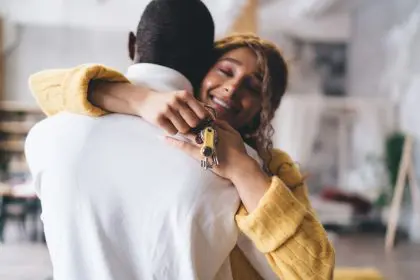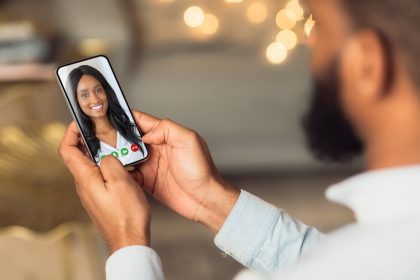Remember those early days when just a glance from your partner made your heart race? When getting ready for date night involved actual butterflies? If those feelings have faded into the comfortable but somewhat predictable rhythm of long-term love, you’re not alone. The good news? That initial electricity hasn’t disappeared – it’s just waiting for someone to flip the switch.
Long-term relationships offer security, deep connection, and the comfort of truly knowing another person. But let’s be honest – maintaining that delicious tension that made you unable to keep your hands off each other? That takes a little more work after the honeymoon phase ends. The missing ingredient might be simpler than you think.
The science behind why flirting fades
That intoxicating early-relationship energy doesn’t just feel like a drug – it actually works like one in your brain. When you first meet someone attractive, your brain floods with dopamine, creating that excited, confident, and slightly addictive feeling that makes flirting feel so natural.
As relationships settle into stability, your brain chemistry shifts. That initial cocktail of excitement-inducing hormones gives way to bonding chemicals like oxytocin. Great for feeling secure and attached, but not so great for maintaining that edge-of-your-seat anticipation that made everything feel electric.
This biological shift isn’t a relationship death sentence – it’s simply your brain’s way of transitioning from infatuation to deeper attachment. The problem happens when couples mistake this natural evolution for a loss of attraction or passion, rather than recognizing it as an invitation to be more intentional about keeping the spark alive.
Why playful tension matters more than you think
Flirting isn’t just about the chase – it serves crucial functions even after you’ve “caught” each other. Regular flirtation creates moments of positive tension that break through routine, reminding both partners that you’re not just roommates or co-parents, but lovers who still find each other desirable.
These playful exchanges trigger the same reward pathways in your brain that lit up during your early dating days. Each flirtatious moment creates a mini-boost of dopamine, reinforcing your attraction and counteracting the familiarity that can sometimes dampen desire.
Perhaps most importantly, consistent flirting maintains a crucial element that many long-term relationships lose – the sense that your partner still needs to earn your attention sometimes. Not in a game-playing way, but in the healthy recognition that attraction requires a little space and effort to flourish, even years into a relationship.
Turning everyday moments into opportunities
The art of long-term flirting often looks different from those initial dating days. Rather than relying on the uncertainty and novelty that fueled early attraction, successful couples learn to transform ordinary moments into opportunities for connection.
Morning routines offer perfect flirting potential that most couples completely miss. Instead of the parallel play of getting ready separately, try a lingering touch as you pass in the hallway or a whispered “You look incredible in that shirt” as they get dressed. These tiny moments require minimal effort but remind your partner they’re still desired.
Technology provides another often-overlooked flirting channel. The same phone you use to text about groceries and childcare can become a private connection to your more playful side. A midday message saying “I can’t stop thinking about the way you looked this morning” creates anticipation that carries through until you’re together again.
The key is consistency without predictability. Regular enough that flirting becomes part of your relationship culture again, but varied enough that it doesn’t become just another routine. This balance keeps the tension alive without feeling forced or scheduled.
Phrases that create instant chemistry
Sometimes the hardest part of reintroducing flirtation is simply finding the words. When you’ve been together for years, expressing desire can suddenly feel awkward or vulnerable in ways it never did during dating.
“If you keep looking at me like that, I’ll forget what I’m trying to say” works beautifully during ordinary conversations, creating an unexpected moment of awareness that breaks through familiarity. The slight vulnerability in admitting they still affect you this way often proves more powerful than grand romantic gestures.
For public situations, whispered comments like “If we weren’t in public right now, I’d be all over you” create delicious private tension in shared spaces. This contrast between your public faces and private connection rebuilds the thrilling sense that you share something others don’t see.
Bringing up specific memories works particularly well for established couples. “Remember that time when we…” instantly transports both of you back to a moment of connection, while implying you’d like to create more memories like it. This combines nostalgia with future anticipation – a powerful combination.
The unexpected power of direct invitations
While subtle flirting builds tension, direct invitations create opportunities to act on that tension. Many couples report that straightforward phrases like “Come here” or “I’m going to take a shower. Want to join me?” cut through the mental clutter of daily life more effectively than hints or suggestions.
These direct approaches work because they eliminate the uncertainty that sometimes develops in long-term relationships. After years together, partners often become hesitant to initiate connection, worried about rejection or disrupting routines. Clear invitations bypass these concerns, creating a straightforward path to intimacy.
The timing of these invitations matters. Moments of transition – coming home from work, finishing household tasks, getting ready for bed – provide natural openings where you’re already shifting from one mode to another. These threshold moments are when partners are most receptive to changing the emotional temperature.
Why appreciation might be the sexiest thing you say
While explicitly sexual comments certainly have their place, expressions of genuine appreciation often create more profound connection. Statements like “You’re so sexy” or “You smell so good” acknowledge your partner as an object of desire, not just a functional role-player in your shared life.
These appreciative comments work best when they’re specific rather than generic. Noticing and commenting on particular qualities – the way they look in certain clothes, how they sound when they laugh, the feeling of their skin – shows you’re truly paying attention, not just going through relationship motions.
The power of these comments comes partly from their unexpectedness. In established relationships, partners often stop verbalizing attraction, assuming it’s understood. Breaking this pattern of assumption with direct appreciation creates surprise and pleasure that generic compliments can’t match.
Building anticipation throughout the day
Some of the most effective flirting happens hours before any physical possibility of acting on it. Messages like “I have a surprise for you tonight” or “Guess what I’m not wearing” create anticipation that transforms an ordinary day into foreplay.
This extended tease works because anticipation activates the brain’s reward system, creating pleasure not just in the experience itself but in looking forward to it. By stretching this anticipation across hours, you essentially extend your intimate connection beyond just the time you’re physically together.
The beauty of this approach is its flexibility. Even on the busiest days with limited time together, these small moments of connection can maintain your romantic thread. A single text or whispered comment can create hours of positive anticipation with minimal time investment.
Why vulnerability might be your secret weapon
Perhaps counterintuitively, some of the most effective flirting involves showing vulnerability rather than confidence. Phrases like “You’re making me blush” or “I really missed you” reveal that your partner still has emotional power in your life – something many long-term relationships gradually lose.
This vulnerability creates a positive feedback loop. When you show that your partner still affects you emotionally, they feel more desirable and confident, which in turn makes them more likely to initiate flirtation themselves. This reciprocal pattern can transform relationship dynamics surprisingly quickly.
The most sustainable relationships maintain this delicate balance – secure enough for safety, but with enough vulnerability to keep things interesting. Flirting sits perfectly at this intersection, combining the confidence that comes from knowing you’re loved with the slight uncertainty that keeps attraction alive.
The art of keeping romance alive isn’t about recapturing exactly what you felt in those early days. It’s about intentionally creating new moments of connection that honor both your history together and your continuing potential to surprise each other. With consistent attention to these small but meaningful exchanges, that spark you’re missing might just turn into a steady flame.
















